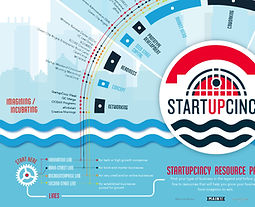
Explore by Chapter
The Atlas is divided into three sections: the Past, which explores the region's early industrial foundations and shifts in consumer habits; the Present, which focuses on land use, food access, and local food connections over the last 20–25 years; and the Future, which imagines possibilities for sustainable cities and agricultural innovation in the coming decades.
PAST
The region's food system is shaped by the practices of First American tribes and European settlers, blending indigenous knowledge with new agricultural methods.
Geography and innovation helped Cincinnati rise as the "Queen of the West," shaping its food system through the Shakers' agricultural advances, the growth of pork packing, the founding of Procter & Gamble, and its early leadership in viticulture and beekeeping.
From 1870 to 1915, railroads and railcar refrigeration expanded shipping, while Cincinnati led in food industry advances, including Kroger’s empire. As supply chains grew, safety laws like the 1906 Meat Inspection Act paved the way for today’s Food Safety Modernization Act (FSMA).
From 1915 to 1950, automobile development reshaped city planning and food access. Cincinnati saw innovations like Kroger’s empire and Jones’ refrigeration. National food policy grew with acts like the Agricultural Adjustment and National School Lunch Acts, while convenience foods and local brands like Graeter’s and Kroger expanded nationally.
PRESENT
Land use policies impact agriculture, trade, biodiversity, and ecosystem health. In the Midwest, Ohio’s Current Agricultural Use Value (CAUV) tax formula has influenced farmland values, which have fluctuated due to factors like oil prices and agricultural product values.
Food manufacturing and distribution are largely unseen. This section explores how food moves from farm to table, featuring a sensory map of local production, the journey of coffee, the decline of butcher shops, and the national reach of Kroger and Klosterman, along with local restaurants sourcing ingredients.
Human connections to food have shifted from direct sources to industrial agribusiness over the past 250 years. This section explores food access issues, including historical influences, immigrant contributions, and local solutions like Produce Perks Midwest and efforts in Covington and Walnut Hills.
Asset-Based Community Development (ABCD) uses community-created asset maps to highlight neighborhood strengths, including food sources and greenspaces, to address food security, justice, and local empowerment. These artistically enhanced maps foster discussions on food system impacts and counteract issues like redlining and gentrification.
Modern consumers often ask questions to understand their food's origins and ingredients, sparking a movement around home production, direct-to-consumer models, and policy impacts. This section highlights local farms, chicken regulations, milk history, farmer's markets, and the growth of wine and beer industries, concluding with a look at the regional pizza and barbecue scene.
From 1915 to 1950, automobile development reshaped city planning and food access. Cincinnati saw innovations like Kroger’s empire and Jones’ refrigeration. National food policy grew with acts like the Agricultural Adjustment and National School Lunch Acts, while convenience foods and local brands like Graeter’s and Kroger expanded nationally.
This section covers agricultural education in Cincinnati, highlighting nonprofits like Turner Farm, the Zoo’s Plant for Pollinators Challenge, Bowyer Farm, and the Civic Garden Center. It also features Cincinnati Public Schools' agricultural programs, a food science project, and community-supported agriculture, concluding with an urban garden plot plan.
Bill Mollison’s Permaculture Design Certification (PDC), launched in 1978, spread globally to address major human challenges. This section of the Atlas highlights the regional permaculture movement, including forest gardens, key local figures, and the Madisonville Woodland Forage Garden, concluding with art that celebrates local perennial edibles.
FUTURE
This chapter outlines the collaboration with existing incubators like Mortar, Flywheel, Main Street Ventures, and Cintrifuse to achieve future goals. It also emphasizes addressing current inequities through the development of new businesses and systems, such as Produce Perks' vision for a New Food Benefit System.
This chapter explores the possibility of future planners and designers drawing inspiration from Permaculture and Living Design principles. It envisions cities that grow more of their own food, generate renewable energy, capture rainwater, and create spaces that regenerate ecological systems. It also imagines neighborhoods connected by bike and walking trails, shared orchards, and public art.
This chapter envisions transforming food systems through better Cold Chain refrigeration, managing food scraps to reduce waste and emissions, and introducing mobile meat processing units for small livestock operations. It also explores the growth of Seed to Fork restaurants, community-supported agriculture, and local beer, wine, and spirit production in all communities.
This chapter imagines businesses prioritizing people and the planet alongside profit. It envisions healthy corner store models, consumers understanding the journey of their coffee beans, and restaurants sourcing as much food as possible from the local region.
This chapter explores the potential of growing organizations and their educational programs, imagining a culture that embraces Slow Food, Climate Safe Neighborhoods, and expanded agricultural education and teaching kitchens.

%2028.jpg)
%2045_edited.jpg)
%2067_edited.jpg)
%2084_edited_edited.jpg)
%20117_edited.jpg)
%20125_edited.jpg)
%20142.jpg)
%20151.jpg)
%20168.jpg)
%20177.jpg)
%20186.jpg)
%20202.jpg)
%20220.jpg)
%20227.jpg)
%20240.jpg)
%20251.jpg)
%20257.jpg)